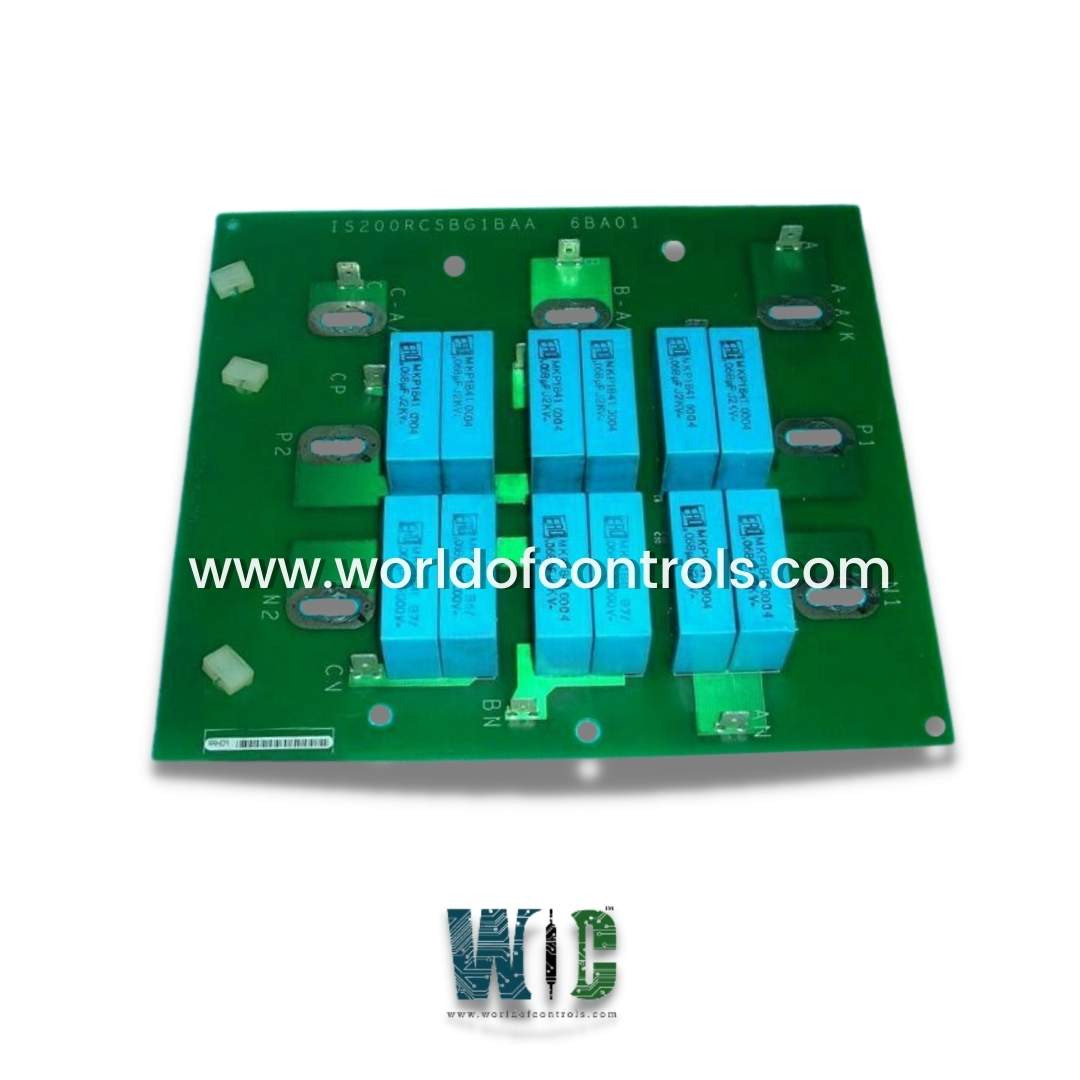SPECIFICATIONS
Part Number: IS200RCSBG1B
Manufacturer: General Electric
Series: EX2100
Function: RC Snubber Board
Availability: In Stock
Product type: PCB
Country of Manufacture: United States (USA)
Functional Description
IS200RCSBG1B is an RC snubber board designed and developed by GE. It is a part of EX2100 excitation system. The EX2100 includes a powerful diagnostic system as well as a control simulator to facilitate quick installation, tuning of control constants, and training. The exciter is a modular system that can be assembled to provide a variety of output currents as well as various levels of system redundancy. Power from a potential, compound, or auxiliary source is one of these options. There are single or multiple bridges, warm backup bridges, and simplex or redundant controls. The exciter is a modular system that can be assembled to provide a variety of output currents as well as various levels of system redundancy.
Product Attributes
The 620 Frame RC Snubber board is a specialized component designed to enhance the performance of a 620 frame SCR/diode source bridge by incorporating capacitors for SCRs (Silicon Controlled Rectifiers) and diodes in a single phase. This board is versatile, as it can build a single bridge using just one card, contributing to the efficiency and functionality of the system.
Capacitor Arrangement and Specifications
The board comprises twelve capacitors organized into six pairs, strategically arranged in two rows of three pairs each. Each capacitor within these pairs is specifically designed with:
- Clamping current of 8.5 Apk, ensuring effective current regulation during operation.
- RMS current rating of 0.5 A, contributing to consistent performance within the system's operational parameters.
- Capacitance range varying between 0.095 to 0.150 F, allowing for optimized energy storage and release.
Terminal Connections and Stab-On Connectors
- The board features four terminal connections, comprising two negative and two positive terminals, facilitating secure and stable connections within the system.
- Additionally, six stab-on connectors are arranged in two rows of three each on the board, enabling easy and efficient connectivity.
Board Specifications and Identification
- The board itself is drilled in several locations, enhancing its structural integrity and facilitating secure mounting within the system architecture.
- It is prominently labeled with the GE logo, the code 6BA01, and a unique board number for easy identification and traceability within the system.
System Features
- A single or redundant control with a customer interface subsystem, local operator keypad(s), optional control operator interface (COI) remote touchscreen interface, control power input module, and power module is used in the architecture.
- A bridge interface subsystem, power bridge, ac and dc filter networks, and ac and/or dc isolation devices comprise the power module. The EX2100 can desensitize the effect of the exciter time constant in SCT-PPT regulator and dc rotating exciter regulator applications. To improve response time to system transients, the EX2100 regulator incorporates direct measurement of the generator field voltage and field current.
Crowbar
- Purpose of the Crowbar Subsystem:
- The crowbar subsystem is designed to limit high negative voltages that can be induced into the Pulse Control Module (PCM) during a pole slip event.
- A pole slip occurs when there is a loss of synchronization between the generator and the electrical grid, resulting in rapid changes in voltage and frequency.
- High negative voltages during a pole slip event can pose a risk to the PCM and other components within the system.
- Self-Firing Crowbar:
- The crowbar subsystem incorporates a self-firing mechanism that activates based on selective field voltage limits.
- When the field voltage exceeds a predetermined threshold, the crowbar initiates a short-circuit path to redirect excessive energy away from the PCM.
- This action protects the PCM and other sensitive components by preventing damage caused by overvoltage conditions.
- Discharge Resistor:
- The crowbar subsystem includes a discharge resistor, which helps dissipate the excess energy during the crowbar operation.
- In certain configurations, the discharge resistor may be shared with the de-excitation function, which is responsible for reducing the magnetic field in the generator.
- This sharing of the discharge resistor optimizes space and resources within the system, especially in generators with salient poles, typically found in hydroelectric applications.
- Salient Pole Generators:
- The crowbar subsystem and its associated discharge resistor are commonly provided in generators with salient poles, which are characteristic of hydroelectric applications.
- Salient pole generators have a distinctive pole shape, and their operating characteristics can lead to specific challenges during pole slip events.
- The crowbar subsystem, along with the de-excitation function, helps mitigate the risks associated with pole slip events in these specific generator configurations.
WOC is happy to assist you with any of your GE requirements. Please contact us by phone or email for pricing and availability on any parts and repairs.
FREQUENTLY ASKED QUESTIONS
What is IS200RCSBG1B?
It is an RC snubber board designed and developed by GE.
What are the specifications of each capacitor on the board?
Each capacitor has a clamping current of 8.5 Apk, an rms current of 0.5 A, and a capacitance of 0.095 to 0.150 F.
What terminal connections and stab-on connectors are on the board?
The board has four terminal connections (two negative and two positive) and six stab-on connectors. The stab-on connectors are arranged in two lines of three on the board.
Is the board pre-drilled and labeled?
Yes, the board is pre-drilled in several places and labeled with the GE logo, the code 6BA01, and the board number.
Where can additional information on the board be found?
Additional information on the board can be found in GE publication GEI-100295, which includes application data, snubber circuit requirements, and mechanical requirements.
